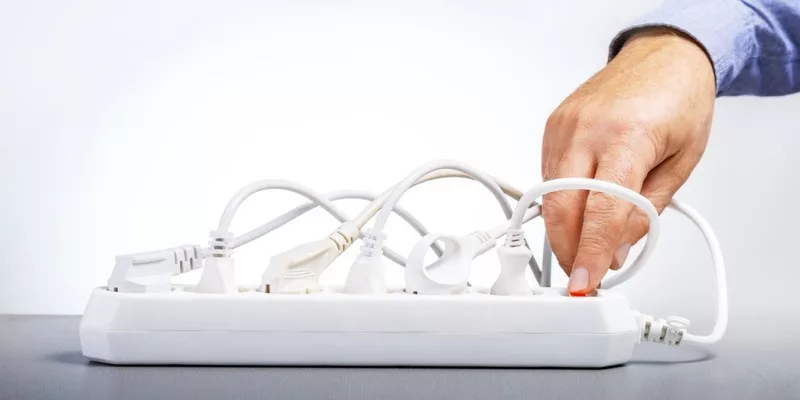How Important is Surge Protection to Your Home?

If you’re wondering whether or not it’s worth having surge protection in your home, the only response is: Yes, it is.
By taking this basic precaution, you not only protect your appliances but you also protect yourself and your family. And having surge protection can be convenient when you have a plethora of appliances and devices that need power.
But what exactly is it and why do you need it? We’ll take a closer look at what surge protection is, what it does and why you need it. If you’re in any doubt about it, consult a qualified professional electrician about the importance of surge protection.
What is a Surge Protector?
A surge protector essentially defends your computer, home theatre system and other electronic appliances and devices from sudden power surges in electricity. Standard Australian voltage in the home is 240 volts. Any voltage over this amount can damage appliances and devices that are connected to a power outlet.
Surge protectors usually come in the form of a power strip (sometimes called a power board), giving you multiple plugs for your appliances and devices. Not all power strips are surge protectors, of course, so if you are looking for surge protection be sure to look for the words “protection” or “surge suppressant” on the unit.
When shopping for a surge protector, look for units that have:
- Indicator lights – surge protectors have a limited lifespan, depending on how often they’re forced to work. The indicator light lets you know if it’s still working or not.
- An Underwriters Laboratories (UL) rating – this independent group tests the safety of electronic devices. All units should have a UL rating.
- Quick response time – A response time of one nanosecond or faster.
Make sure you check your surge protector if you’ve experienced a major surge, prolonged power outage or lightning strike, and replace it if necessary.

How Does a Surge Protector Work?
A surge protector essentially channels excess voltage into the outlet’s ground wires, which prevents the surge from flowing through your equipment and damaging it.
Most surge protectors use a metal oxide varistor (MOV) as a link between the unit’s hot wire and grounding wire. The MOV can make adjustments to incoming voltage, whether it’s too high or too low.
When there’s a voltage spike, the MOV redirects only the excess voltage into the grounding wire, making it harmless. A safe level of voltage continues to flow uninterrupted into the device or appliance.
What Causes Power Surges?
Keep in mind that not even the best surge protectors can save your equipment and resist the power of lightning in an electrical storm. A lightning strike is measured in hundreds of millions of volts. The best course of action is to unplug devices during an electrical storm.
The main purpose of surge protectors is to defend your appliances and devices from lower-voltage surges that occur in modern electrical systems. The main cause comes from your larger devices, such as air conditioners and refrigerators. These require high amounts of energy to switch motors and compressors on and off, which creates surges in power that disrupt the flow of electricity.
Other causes of power surges include faulty wiring, defective outlets, downed power lines and can even come from your electricity provider during grid switching.
Let’s look at the many benefits of having surge protection on your most important equipment.
Protect Your Appliances and Devices
Without adequate surge protection, you risk having some of your most treasured devices and appliances damaged or destroyed by a power surge.
Computers are particularly susceptible to this kind of damage, with electrical surges destroying internal components such as the motherboard or even the hard drive. Power surges can also damage or wreck your television and other audio-visual devices. The higher the power demands of a piece of equipment, the greater the risk of electrical damage.

Protect Against Electrical Fires
Coping with damaged electrical equipment is one thing; reacting to an electrical fire is another extreme. At its worst, a power surge can cause an appliance to burst into flames.
This can become a genuine threat to your family’s safety and your home. Take the following steps in the event of an electrical fire:
- Turn off your electricity and use a fire extinguisher (which sprays carbon dioxide).
- If you don’t have a fire extinguisher, you can smother it in bicarbonate (baking) soda, if it’s a small fire.
- Never use water in an attempt to suppress this type of fire.
- If you can’t extinguish the fire, dial 000 immediately.
More Access to Electrical Outlets
Most people use power strips in their homes, particularly in the lounge room or family room where the television, game station and sound equipment is likely to be.
Using a power strip which is also a surge protector has the benefit of giving you up to 10 power outlets, allowing you to free up your wall powerpoints for lamps and other equipment.
What is the Downside of Surge Protection?
Perhaps the only negative aspect of using a surge protector is that it will possibly be the biggest cause of your RCD (residual current device) switch tripping. This device is part of your main switchboard and is designed to protect you from electrocution.
That’s why it’s recommended to only use surge protection on your most expensive and highly valued electronic equipment, such as desktop and laptop computers and your home entertainment centre.
Peace of Mind for You
The greatest benefit of using surge protection is that you can relax in the knowledge that your most valuable electrical equipment is being protected. Best of all, surge protection also makes your home a safer place to be.
Please note: This information is provided for advice purposes only. Regulations differ from state to state, so please consult your local authorities or an industry professional before proceeding with any work. See our Terms & Conditions here.